National Institute of Information and Communications Technology
Home > Press Release > World's First Application of Wi-SUN Radio Sensor Network to Fishery Industry, MOZUKU Seaweed Aquaculture
World's First Application of Wi-SUN Radio Sensor Network to Fishery Industry, MOZUKU Seaweed Aquaculture
December 25, 2015
- Via the Wi-SUN radio sensors installed in the buoys, water temperature and salinity data are periodically collected and stored in the cloud.
- Battery driven floatable buoys exploiting low-energy multi-hop capability of Wi-SUN enables effective expansion of monitoring area.
- By collaborating with the local fishery cooperative, NICT plans further optimization of monitoring items.
NICT has successfully applied the Wi-SUN radio sensor network to the MOZUKU seaweed aquaculture, which is considered as the world's first Wi-SUN application to the fishery industry. In this case, three buoys that equip battery driven low-energy Wi-SUN devices (two of them further equip the water-temperature and salinity sensors) are located in the MOZUKU seaweed farm in Nanjo, Okinawa, Japan, 1~2 km away from the land. Periodically monitored water-temperature and salinity data are collected via the low-energy multi-hop communications among the buoys and then stored in NICT’s cloud to be managed. NICT has determined and is going to optimize suitable monitoring locations and other conditions via the collaborations with Chinen fishery cooperative. The achievements imply effective and flexible Wi-SUN applications to various fields in the future.
Background
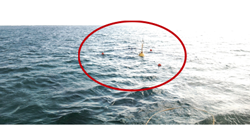
Wi-SUN device installed buoy
NICT has been promoting the global standard Wi-SUN compliant radio devices through R&D, IEEE 802.15.4g/4e standardization and certifications by the Wi-SUN alliance, by harmonizing with the increasing demand for radio communications for smart meters and sensors. There were various Wi-SUN applications in the agricultural industry where agricultural sensors equipped with Wi-SUN devices are installed in the bare ground and greenhouses. Whereas the effectiveness of such Wi-SUN application to the continual monitoring in the fishery industry has been expected, many differences in the conditions in the fishery industry case, such as radio propagation characteristics, monitoring area sizes and battery replacing cost, have delayed the practical installations.
Achievements
NICT has installed three buoys that equip battery driven low-energy Wi-SUN device in the MOZUKU seaweed farm in Nanjo, Okinawa, Japan. Two of those are buoys with the water temperature and salinity sensors. Additionally, two Wi-SUN devices are installed in the data collection station on the land. NICT has succeeded in the periodical water temperature and salinity data collection through the four-hop multi-hop communications configured with all Wi-SUN radio devices deployed on both land and sea. The collected data are stored in NICT’s cloud via the Internet, which is accessible from the remote locations.
Since the Wi-SUN radio device attached on the buoy assumes battery driven operations, the device is capable of low-energy operation via the intermittent communication mechanism employing effective sleep periods that is proposed by NICT and standardized in IEEE 802.15.4e standard.
Future perspectives
NICT plans to modify and optimize monitoring conditions, such as communication intervals, low-energy functions, monitoring data and monitoring locations, according to the demand of Chinen fishery cooperative that NICT collaborates with. NICT is further planning Wi-SUN promotion in various fields.
Appendix
Details on the achievements
<Installation details of Wi-SUN devices equipped on buoys>
● Locations
● Locations
Fig. 1 shows the locations of buoy installations. Wi-SUN devices are located in the MOZUKU seaweed farm and in the land facilities in Nanjo, Okinawa, Japan that are managed by Chinen fishery cooperative. Fig. 2 shows its topology. Two buoys out of three equip water temperature and salinity sensors.
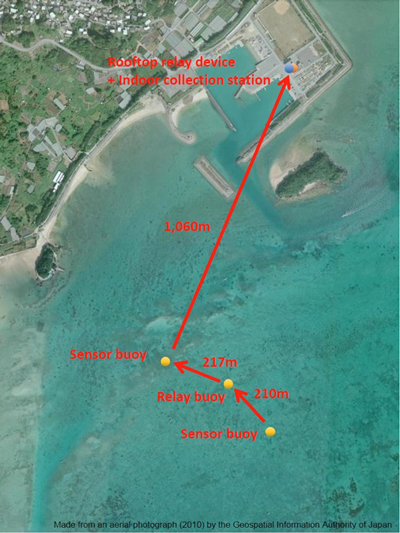
Fig.1 Locations
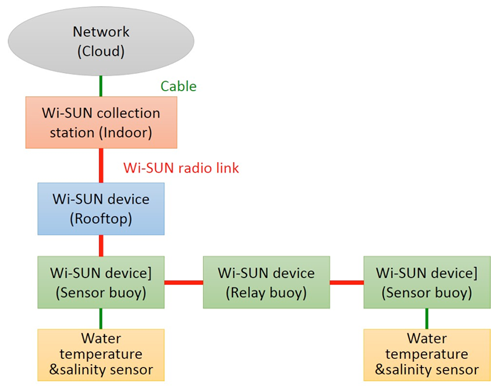
Fig.2 Topology
● Details of the buoy
Fig. 3 shows details of the installed buoys. The buoy is connected with the underwater sensors for water temperature and salinity sensing and is fixed by floats and sinkers. A Wi-SUN radio device is located in the top of the buoy with 1m height from sea level. Fig. 4 shows an appearance of the located buoy.
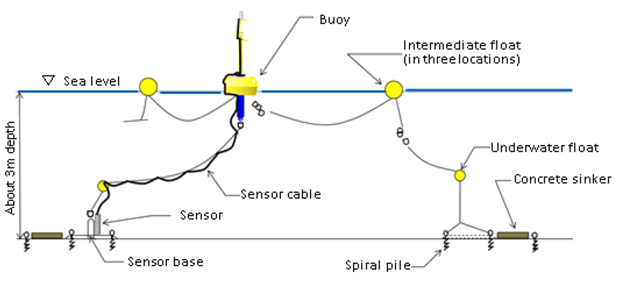
Fig. 3 Configurations of the buoy: (a) Outline of installations
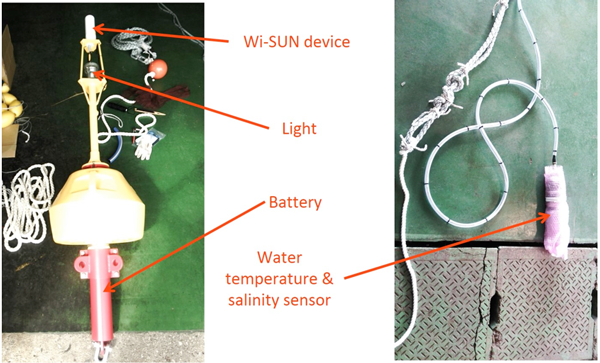
Fig. 3 Configurations of the buoy: (b) Outline of buoy
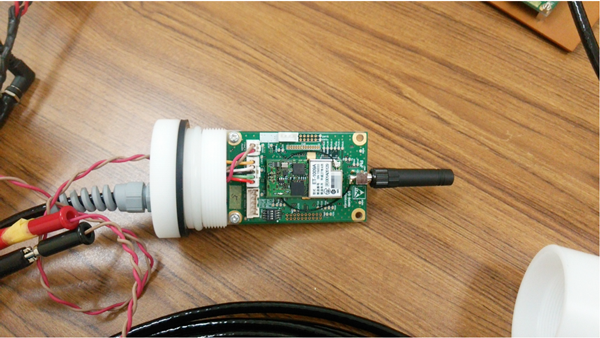
Fig. 3 Configurations of the buoy: (c) Wi-SUN radio device
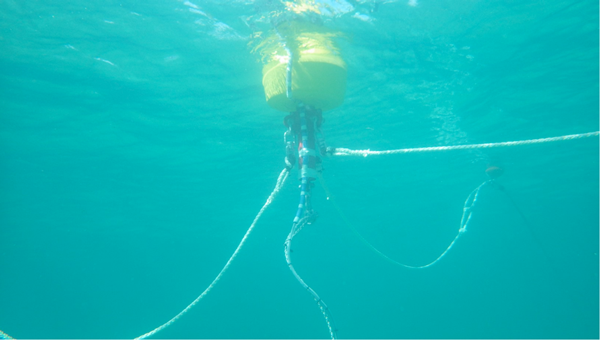
Fig. 4 Buoy installation outline: (a) Underwater vision
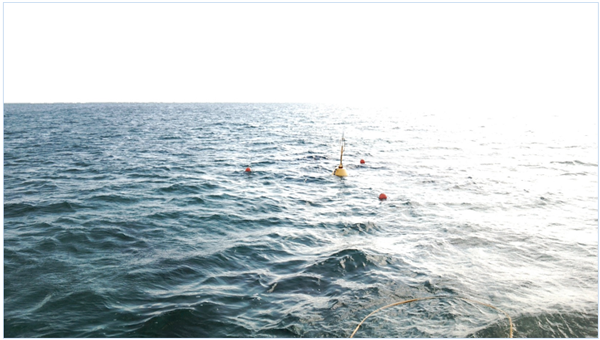
Fig. 4 Buoy installation outline: (b) Overwater vision
<Confirmation of monitoring data>
Fig. 5 shows confirming vision of stored data in the cloud. Displaying after some calculations on data such as averaging, and displaying data with the imported data, for example independently obtained rainfall data in this region are possible.
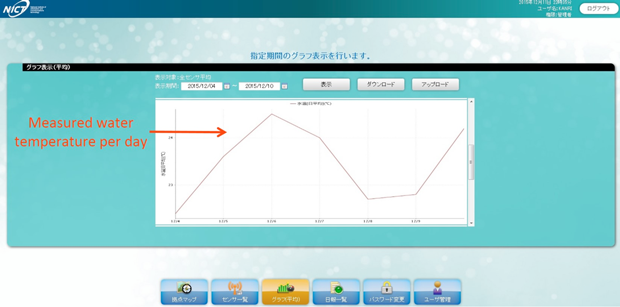
Fig. 5 Confirming vision of monitoring data: (a) water temperature graph
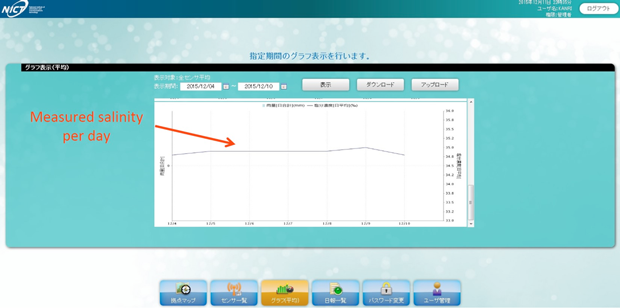
Fig. 5 Confirming vision of monitoring data: (b) salinity graph
<Details of low-energy operation>
Fig. 6 shows an example of low-energy operation of the Wi-SUN radio device employed in this achievement. This operation is defined as an access control mechanism known as low-energy superframe (LE Superframe) that is proposed by NICT and is included in the IEEE 802.15.4e standard. In this mechanism, each radio device periodically employs intermittent and short active periods for data exchange. Besides such active period, the device employs sleep period that occupies the most part of its operation, thereby effectively improves the average power consumption performance. Fig. 6 shows an example where the device becomes active state for only 12 seconds in 2 hours data interval.

Fig. 6 Low-energy operation of Wi-SUN radio device
Glossary
The Wi-SUN alliance is an organization that supports certification and promotion for radio devices for SUN (smart utility networks) by assuming IEEE 802.15.4g standards adoption for low-power smart meter radio systems. The Wi-SUN alliance is established on Jan. 24, 2012. NICT is a promoter member of the Wi-SUN alliance. The certifications by the Wi-SUN alliance are based on the definition of the protocol stacks with PHY, MAC and higher layer specifications according to the assumed applications. Each of such stacks is called as the Wi-SUN profile for the application.
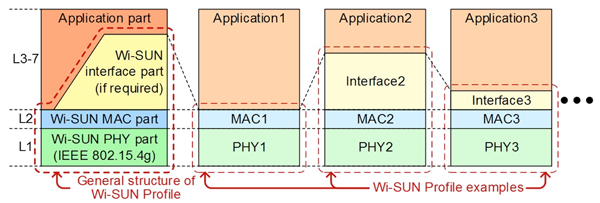
Multi-hop transmission means a transmission that includes more than one relaying by other radio device(s) than transmitter and receiver devices, which is different from the direct transmission between devices. The reachable range of the multi-hop transmission can be proportionally expanded to the number of relaying. Moreover, the multi-hop transmission enables the same reachable range as a direct transmission with lower transmission power for each device than that of the direct transmission. Furthermore, the multi-hop transmission can also provide relaying route avoiding obstacles for radio waves, thereby eliminate radio blind spots.
IEEE 802 committee is a committee engaged in the standardization for communication systems such as LAN in IEEE (Institute of Electrical and Electronics Engineers) that is a non-profit professional association dedicated to advancing technological innovation related to electricity. In the committee, a working group (WG) named IEEE 802.15 deals with the standardization for wireless personal area networks (WPAN). This WG accommodates several task groups (TGs) as depicted below, each of which is organized according to its goal.
IEEE 802.15.4:
IEEE 802.15.4 is a TG that has standardized the PHY and MAC specifications for low-rate wireless personal area networks. In the IEEE 802.15.4 standard, PHY specifications define 20 kbps, 40 kbps and 250 kbps data transmissions on 868 MHz, 902 MHz and 2.4 GHz frequency bands respectively. Moreover, MAC specifications define a concept of the device group named PAN and access control schemes such as TDMA or CSMA held in the PAN.
IEEE 802.15.4g:
IEEE 802.15.4g is a TG that has standardized the necessary PHY amendments in the existing IEEE 802.15.4 standard that are required in order to realize SUN. This standard defines additional modulation schemes and frequency bands, and expanded data payload.
IEEE 802.15.4e:
IEEE 802.15.4e is a TG that has standardized the accompanying MAC modifications with any of PHY amendments in the existing IEEE 802.15.4 standard as for IEEE 802.15.4g. This standard defines intermittent data exchange functions with low-power consumption as one of the typical modifications related to SUN.
Technical contact
Fumihide Kojima
Smart wireless laboratory
Wireless network research institute
Tel: +81-46-847-5084
E-mail: 



























Media Contact
Sachiko Hirota
Public relations department
Tel: +81-42-327-6923
Fax: +81-42-327-7587
E-mail: 


























